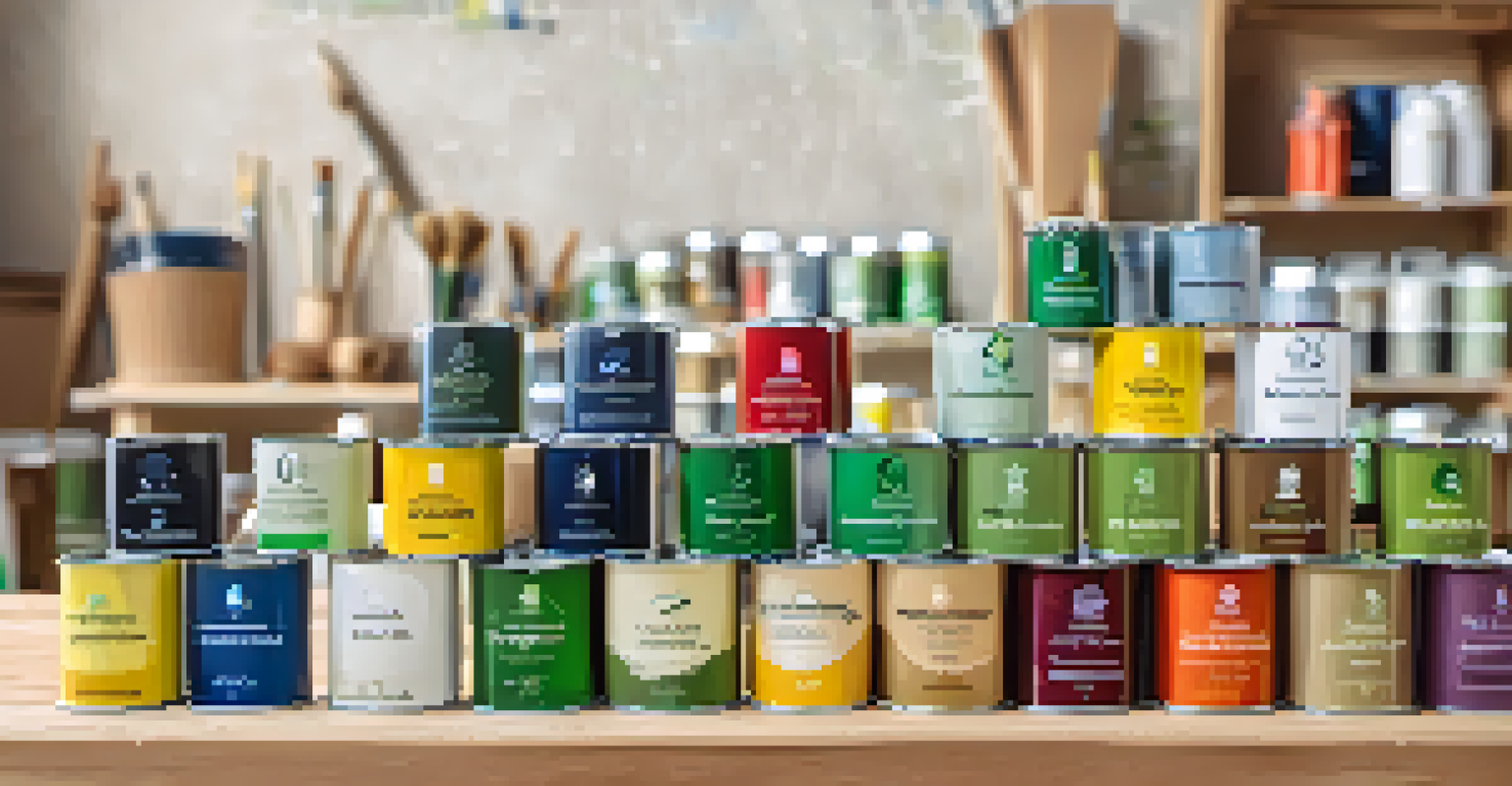How to Source Eco-Friendly Paints for Home Renovations

Understanding the Importance of Eco-Friendly Paints
Using eco-friendly paints is crucial for both your health and the environment. Traditional paints often contain volatile organic compounds (VOCs), which can release harmful chemicals into the air. These substances can lead to respiratory issues and contribute to indoor air pollution, making eco-friendly options a smarter choice.
The greatest threat to our planet is the belief that someone else will save it.
Eco-friendly paints are made from natural ingredients, which means they are less likely to emit harmful fumes. This not only benefits the environment but also creates a safer living space for you and your family. Choosing these paints can also reduce your carbon footprint, aligning your home renovation with sustainable living practices.
Moreover, many eco-friendly paints come in a variety of colors and finishes, debunking the myth that they are less versatile than conventional options. With the growing demand for sustainable products, manufacturers are continuously improving their offerings, ensuring you don't have to compromise on aesthetics for health.
Identifying Eco-Friendly Paint Certifications
When sourcing eco-friendly paints, it's essential to look for certifications that verify their claims. Certifications like Green Seal and EcoLogo ensure that the paint meets stringent environmental standards. These labels can provide peace of mind, helping you make informed decisions about the products you use in your home.

Another notable certification is the Greenguard certification, which indicates that a product has been tested for chemical emissions. This is particularly important for paints, as it ensures that the indoor air quality won't be compromised after application. Checking for these certifications can help you easily distinguish between truly eco-friendly paints and those that are simply marketed as such.
Health Benefits of Eco-Friendly Paints
Eco-friendly paints reduce indoor air pollution and harmful chemical exposure, creating a safer environment for you and your family.
Additionally, some manufacturers are transparent about their ingredients and production processes, so don't hesitate to ask for this information. A reputable brand will be happy to share details about their eco-friendly practices and the specific certifications their products hold.
Researching Eco-Friendly Paint Brands
Start your search for eco-friendly paints by researching brands that prioritize sustainability. Many companies have dedicated themselves to producing environmentally friendly products, so look for those with a strong reputation in the market. Online reviews and testimonials can provide valuable insights into the quality and performance of different brands.
We do not inherit the earth from our ancestors, we borrow it from our children.
Explore local options as well; many regions have small businesses that specialize in eco-friendly paints. Supporting local enterprises not only benefits the community but often results in more sustainable production practices. Plus, these brands may offer unique colors or formulations that larger companies do not.
Don't forget to consider the price point. While eco-friendly paints may sometimes be more expensive than traditional options, think of them as an investment in your health and the planet. The longevity and reduced environmental impact can often justify the initial expense.
Exploring Paint Stores and Online Retailers
Once you've identified potential brands, it's time to explore where to buy them. Visit local paint stores that carry eco-friendly options, as staff can provide personalized recommendations and answer questions. Many stores also have samples available, allowing you to test colors before committing to a purchase.
Online retailers are another excellent resource for sourcing eco-friendly paints. Websites often provide comprehensive product descriptions, user reviews, and comparisons between brands. However, make sure to read about shipping practices, as sustainability can be compromised if products are shipped long distances.
Certifications Ensure Quality Choices
Looking for certifications like Green Seal and Greenguard helps you identify truly eco-friendly paints that meet environmental standards.
Additionally, consider joining online communities or forums focused on home renovations and eco-friendly living. These platforms can offer recommendations and insights about where to find the best eco-friendly paints, as well as tips from those who have already completed similar projects.
Understanding Paint Ingredients and Their Impact
To make an informed choice, familiarize yourself with the ingredients commonly found in eco-friendly paints. Look for natural components like plant-based oils, natural resins, and mineral pigments. These materials are not only safer for your health but also contribute to a lower environmental impact.
Avoid paints that contain synthetic additives, such as heavy metals and formaldehyde, as these can be harmful. Understanding the ingredients allows you to choose paints that align with your values and health needs. Furthermore, many eco-friendly paints are biodegradable, which means they break down more easily after disposal.
By prioritizing natural ingredients and avoiding harmful chemicals, you contribute to a healthier ecosystem. This knowledge empowers you to make choices that benefit not just your home but also the broader environment.
Considering the Long-Term Benefits of Eco-Friendly Paints
Choosing eco-friendly paints is not just about immediate aesthetics; it's an investment in the long-term health of your living space. These paints often have better durability, meaning you won’t have to repaint as frequently. This not only saves time and effort but also reduces waste over time.
Additionally, eco-friendly paints tend to have better coverage and application properties, leading to a smoother finish that can enhance the beauty of your home. The reduced need for touch-ups or additional coats can also save you money in the long run.
Long-Term Value in Sustainable Choices
Investing in eco-friendly paints leads to better durability and coverage, ultimately saving you time, money, and appealing to future homebuyers.
Lastly, using sustainable products can increase your home's value, especially as more homebuyers seek environmentally conscious features. By choosing eco-friendly paints, you are not only benefiting yourself but also appealing to future buyers who value sustainability.
Tips for a Successful Eco-Friendly Painting Project
Before starting your project, ensure you have a clear plan and the right tools. Preparation is key to achieving a professional-looking finish. Clean and repair surfaces, and gather all your supplies, including eco-friendly brushes and rollers, to minimize waste and maximize efficiency.
Consider painting during the right season. Proper ventilation is essential when working with any type of paint, so choose a time when you can open windows and allow fresh air to circulate. This not only helps in achieving a better finish but also ensures that any remaining fumes dissipate quickly.

Finally, embrace creativity! Eco-friendly paints come in a variety of colors and finishes, allowing you to express your personal style while being kind to the planet. Don't hesitate to experiment with techniques like stenciling or color blocking to make your project truly unique.